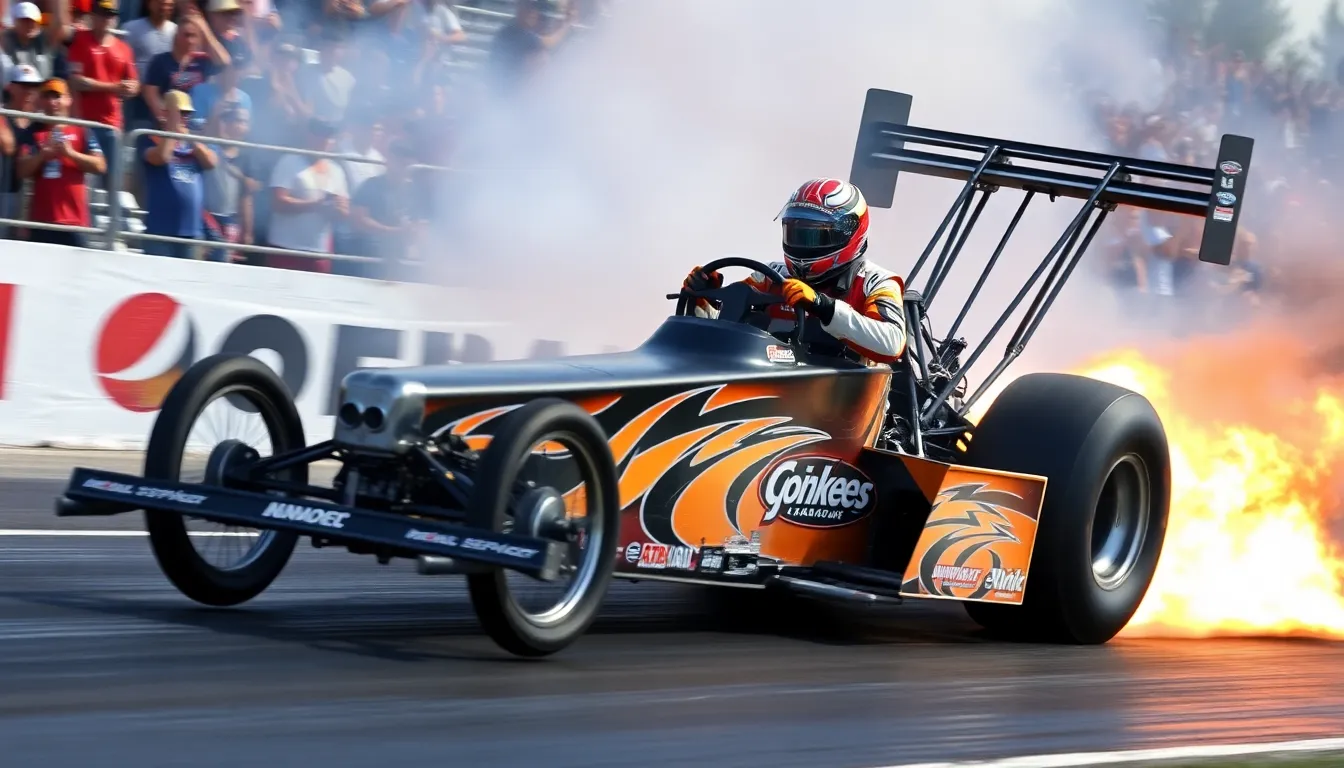When we hear the thunderous roar of engines and smell burning rubber at the starting line, we know we’re witnessing one of motorsport’s most electrifying spectacles. Drag racing represents the purest form of automotive competition – two cars, a quarter-mile strip, and the relentless pursuit of speed.
We’ve all felt that adrenaline rush watching these mechanical beasts launch from zero to over 300 mph in mere seconds. From street-legal muscle cars to purpose-built Top Fuel dragsters that generate more horsepower than a Formula 1 car, drag racing showcases engineering excellence and raw power like no other sport.
Whether you’re a seasoned gearhead or someone who’s just discovered the thrill of quarter-mile racing, we’ll take you deep into the industry of drag cars. You’ll discover what makes these speed demons tick, explore the different classes that compete, and understand why millions of fans can’t get enough of this high-octane addiction.
Understanding the World of Drag Cars and Their Purpose
Drag cars represent the pinnacle of straight-line automotive performance engineering. These specialized machines transform raw horsepower into blistering acceleration through precise modifications and purpose-built components.
What Makes a Car Suitable for Drag Racing
Weight reduction transforms ordinary vehicles into competitive drag machines. We see racers strip interior components like seats, carpeting, and sound dampening materials to shed hundreds of pounds. Carbon fiber hoods, fiberglass body panels, and aluminum components replace heavier factory parts.
Power to weight ratio determines a car’s acceleration potential on the strip. Engines receive extensive modifications including turbochargers, superchargers, or nitrous oxide systems to boost horsepower output. Modern Top Fuel dragsters generate over 11,000 horsepower from their massive 500-cubic-inch engines.
Traction systems maximize the transfer of power to the pavement. Wide rear tires with soft rubber compounds grip the track surface while wheelie bars prevent dangerous front-end lifting. Suspension modifications lower the car’s center of gravity and optimize weight transfer during launch.
Safety equipment protects drivers during high-speed runs. Roll cages constructed from chromoly steel tubing surround the cockpit while five-point harnesses secure drivers in racing seats. Fire suppression systems and fuel cells with safety bladders prevent dangerous incidents.
The Science Behind Quarter-Mile Performance
Launch technique determines the outcome of most drag races within the first 60 feet. We measure reaction times in thousandths of a second as drivers anticipate the green light. Perfect launches require precise throttle control to avoid wheel spin while maximizing acceleration.
Aerodynamic considerations become crucial at speeds exceeding 200 mph. Front air dams reduce lift while rear spoilers provide downforce to maintain traction. Streamlined body shapes minimize drag coefficient allowing cars to slice through air more efficiently.
Gear ratios optimize power delivery throughout the quarter-mile distance. Transmission configurations vary from three-speed automatics in Pro Stock cars to two-speed systems in Top Fuel dragsters. Each gear change occurs at precise RPM points to maintain peak power band operation.
Track conditions significantly impact performance times. Temperature affects air density while humidity levels influence engine combustion efficiency. Track surface preparation with specialized compounds enhances tire grip while timing systems measure elapsed times to the nearest thousandth of a second.
Top Fuel Dragsters: The Ultimate Drag Cars
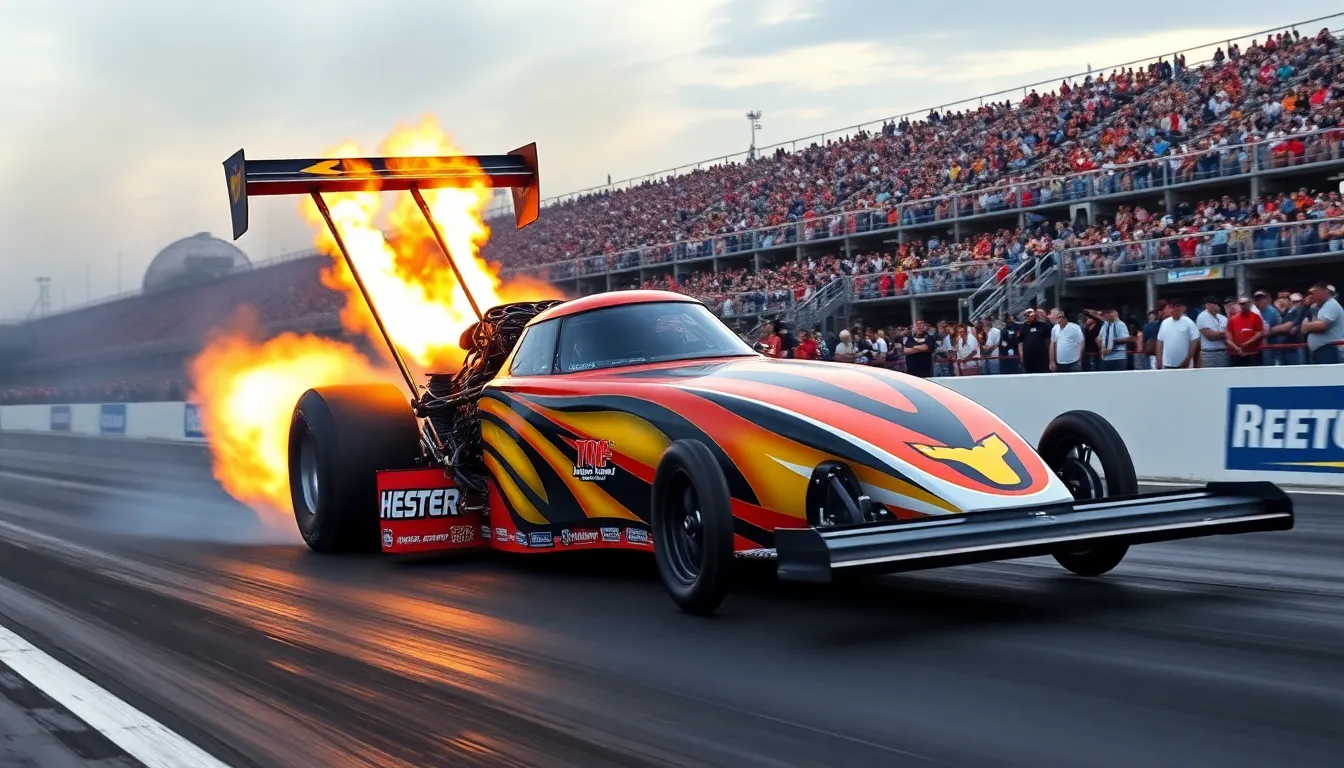
These extraordinary machines represent the absolute pinnacle of drag racing technology and raw power.
Nitromethane-Powered Monsters
Top Fuel dragsters burn nitromethane as their primary fuel source, creating an explosive combination that generates incredible horsepower. Nitromethane contains its own oxygen, allowing these engines to produce nearly twice the power of gasoline-powered equivalents. We’re talking about engines that consume approximately 15 gallons of this specialized fuel during a single quarter-mile run.
The fuel mixture consists of 85-90% nitromethane and 10-15% methanol, creating a highly volatile combination that requires precise handling. These dragsters feature supercharged 500-cubic-inch V8 engines that can produce over 11,000 horsepower at peak performance. Engine rebuilds occur after every single run due to the extreme stress and heat generated by the nitromethane combustion process.
Fuel injection systems deliver this potent mixture through massive injectors that flow incredible volumes per minute. The exhaust flames shoot several feet behind the vehicle, creating the iconic visual spectacle that makes Top Fuel racing so captivating for spectators.
Record-Breaking Speed Capabilities
Top Fuel dragsters currently hold the record for the fastest acceleration of any land vehicle, reaching speeds over 330 mph in just 1,000 feet. These machines can accelerate from zero to 100 mph in less than one second, generating forces that exceed 5 Gs during launch.
| Performance Metric | Top Fuel Dragster Capability |
|---|---|
| Top Speed | 330+ mph |
| 0-100 mph Time | 0.8 seconds |
| Quarter Mile Time | 3.6-4.0 seconds |
| G-Force at Launch | 5+ Gs |
| Horsepower Output | 11,000+ HP |
The current NHRA Top Fuel elapsed time record stands at 3.623 seconds, while the top speed record reaches 338.17 mph. Aerodynamic design plays a crucial role at these extreme velocities, with long, narrow bodies that slice through air resistance while maintaining stability.
Parachute deployment systems become essential safety equipment at these speeds, helping drivers decelerate safely after crossing the finish line. The combination of lightweight construction, massive power output, and advanced aerodynamics creates the ultimate expression of straight-line automotive performance that we witness in modern Top Fuel competition.
Funny Cars: Crowd-Pleasing Drag Racing Machines
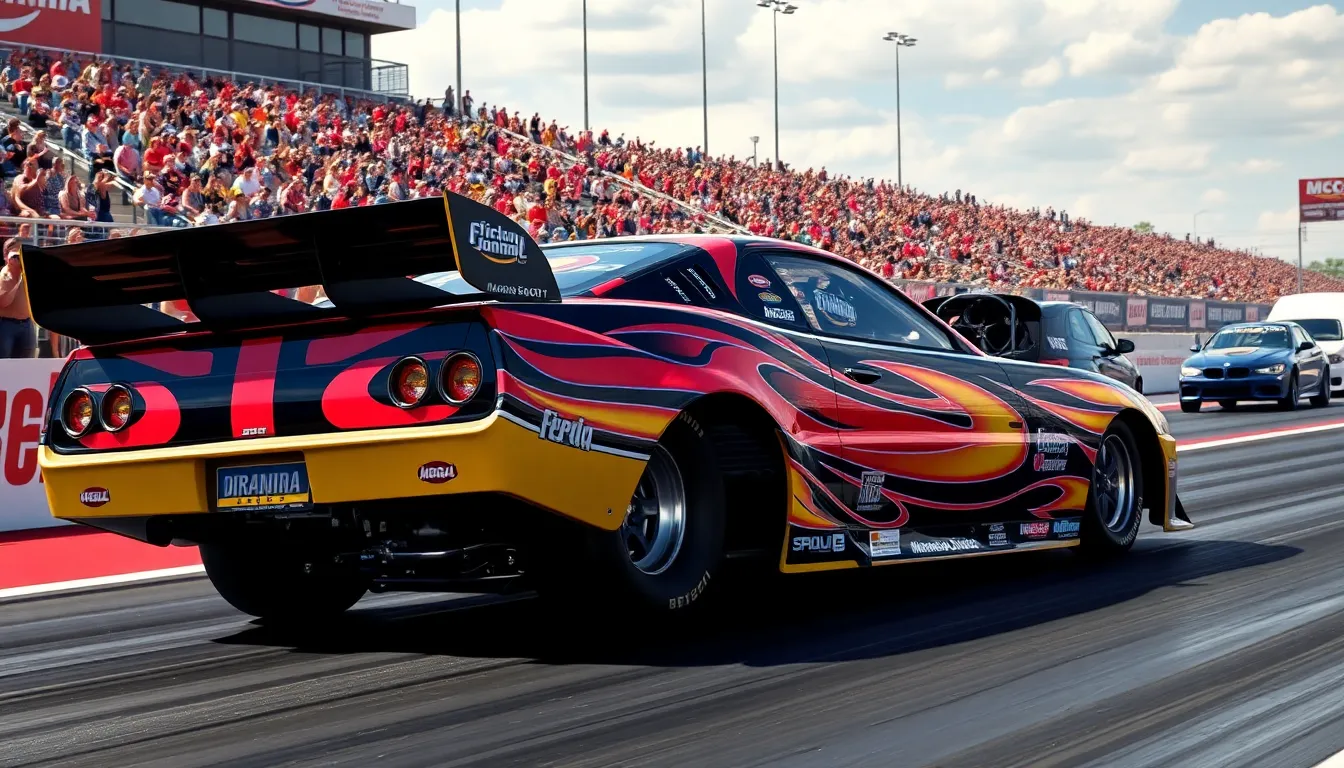
We encounter some of the most visually spectacular vehicles in drag racing when we explore Funny Cars. These remarkable machines combine incredible performance with eye-catching aesthetics that captivate audiences worldwide.
Distinctive Body Styles and Aerodynamics
Funny Cars showcase one-piece fiberglass bodies that flip forward to reveal the intricate mechanical components underneath. These aerodynamically sculpted shells typically replicate production car designs like Camaros, Mustangs, and Challengers while stretching far beyond their factory dimensions. Modern Funny Car bodies extend approximately 25 feet in length with dramatically flared wheel wells and aggressive front splitters that slice through the air.
Aerodynamic efficiency becomes paramount when these machines reach speeds exceeding 330 mph in just over four seconds. Engineers design each body panel to minimize drag while maximizing downforce, ensuring the vehicle remains planted to the track surface. Massive rear spoilers generate crucial downforce at high speeds, while carefully sculpted side panels channel airflow to reduce turbulence around the rear wheels.
Weight distribution plays a critical role in Funny Car performance, with the engine positioned behind the driver for optimal balance. This configuration places the center of gravity precisely where it needs to be for maximum traction during launch. Carbon fiber construction keeps body weight to approximately 200 pounds while maintaining structural integrity under extreme aerodynamic loads.
Professional Racing Circuit Dominance
NHRA Funny Car competition represents the pinnacle of professional drag racing entertainment, drawing massive crowds to major events throughout the racing season. These supercharged machines generate over 11,000 horsepower from their nitromethane-fueled engines, creating the thunderous roar that defines drag racing culture. Professional Funny Car teams invest millions of dollars annually in research, development, and competition expenses to remain competitive.
Championship caliber Funny Car drivers master the art of controlling 2,300-pound rockets that accelerate faster than fighter jets during takeoff. Top competitors like John Force, Ron Capps, and Robert Hight have become household names in motorsports, each bringing unique driving styles to their respective teams. Racing teams employ dozens of specialists including engine tuners, chassis experts, and aerodynamics engineers to optimize every aspect of performance.
Television coverage of NHRA events showcases Funny Cars as the marquee attraction, with their dramatic body styling and explosive acceleration creating perfect visual entertainment for broadcast audiences. Prize purses for major Funny Car events often exceed $100,000 for race winners, while season champions can earn over $500,000 in prize money and bonuses. Corporate sponsorship deals frequently surpass seven figures annually for top tier teams, reflecting the commercial appeal of these crowd-pleasing machines.
Pro Stock Drag Cars: Factory-Based Racing Excellence
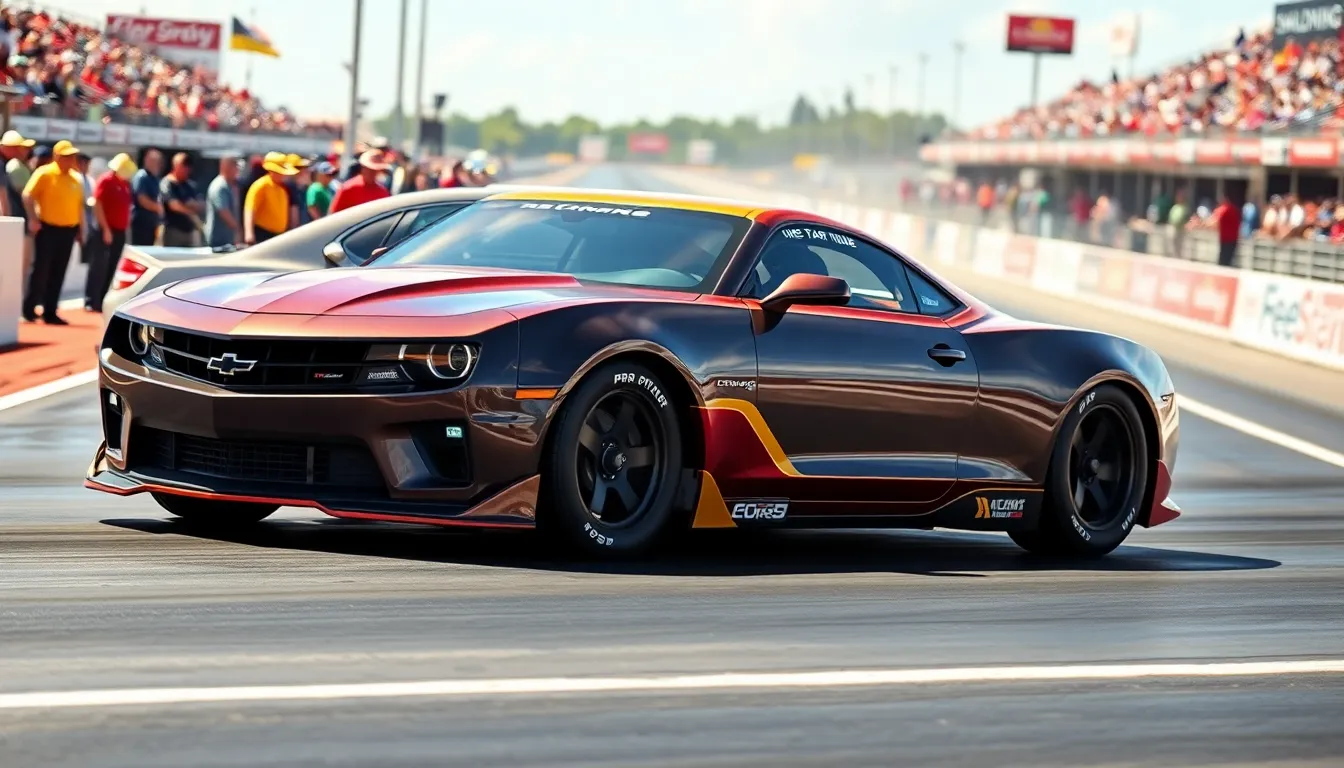
Pro Stock drag cars represent the perfect marriage between production vehicle authenticity and cutting-edge racing technology. We find these incredible machines bridging the gap between street cars and purpose-built dragsters.
Production Car Origins and Modifications
Production car platforms form the foundation of every competitive Pro Stock drag car. We witness racers transforming familiar body shells like the Chevrolet Camaro, Ford Mustang, and Dodge Challenger into quarter-mile missiles. Teams start with factory blueprints but modify nearly every component to meet racing specifications.
Weight reduction becomes the primary focus during the transformation process. We see builders stripping all interior components, replacing steel panels with lightweight carbon fiber alternatives, and installing custom racing chassis. Factory glass gives way to lightweight polycarbonate windows that can withstand the extreme forces of acceleration.
Aerodynamic enhancements distinguish Pro Stock cars from their street counterparts. We observe teams installing front air dams, rear spoilers, and side skirts that channel airflow for maximum stability at speeds exceeding 210 mph. Body modifications must remain within NHRA guidelines while maintaining the recognizable appearance of production vehicles.
Suspension systems undergo complete overhauls to handle the violent launch forces. We find that teams replace factory components with specialized racing setups featuring adjustable shock absorbers, lightweight racing wheels, and purpose-built drag racing tires. Weight distribution becomes critical, with ballast placement precisely calculated to achieve optimal traction.
Engine Regulations and Performance Standards
Engine displacement limits strictly govern Pro Stock competition at 500 cubic inches maximum. We see naturally aspirated V8 engines producing approximately 1,400 horsepower without turbochargers, superchargers, or nitrous oxide systems. NHRA regulations require engines to maintain the basic architecture of their production counterparts.
Fuel specifications mandate the use of racing gasoline rather than exotic fuels like nitromethane. We observe teams pushing the boundaries of naturally aspirated performance through advanced port and chamber designs, custom camshaft profiles, and precision-machined components. Engine builders achieve power outputs that rival some forced-induction applications.
Transmission requirements limit Pro Stock cars to manual five-speed gearboxes. We find that teams optimize gear ratios specifically for quarter-mile acceleration, with some cars shifting four times during a single pass. Clutch systems must handle the enormous torque loads while providing consistent engagement characteristics.
Weight minimums ensure competitive balance across different manufacturers. We see the current minimum weight set at 2,350 pounds, forcing teams to add ballast if their cars fall below this threshold. This regulation prevents unlimited weight reduction that could create safety concerns or competitive imbalances.
Performance standards continue evolving as technology advances. We witness Pro Stock cars routinely running elapsed times in the 6.40-second range at speeds approaching 215 mph, making them among the quickest naturally aspirated vehicles in motorsports competition.
Street-Legal Drag Cars for Weekend Warriors

Street-legal drag cars bridge the gap between professional racing machines and everyday vehicles. These modified rides let enthusiasts experience drag strip thrills while maintaining road worthiness for daily commutes.
Popular Models for Amateur Racing
Chevrolet Camaro SS dominates amateur drag strips with its 6.2-liter V8 engine producing 455 horsepower from the factory. Aftermarket modifications can easily push power levels beyond 600 horsepower while keeping the car street legal. We’ve seen countless weekend warriors choose this platform for its affordable modification potential and strong aftermarket support.
Ford Mustang GT delivers exceptional bang for your buck with its 5.0-liter Coyote V8 generating 450 horsepower. Supercharger kits from companies like Roush and Whipple can boost output to over 700 horsepower while maintaining emissions compliance. The independent rear suspension helps put power to the ground effectively during launches.
Dodge Challenger SRT Hellcat arrives from the factory with 717 horsepower courtesy of its supercharged 6.2-liter HEMI V8. Simple modifications like cold air intakes, exhaust systems, and ECU tuning can unlock an additional 50-100 horsepower. This platform offers the most power per dollar for those wanting serious performance straight from the dealership.
Chevrolet Corvette C8 represents the pinnacle of street-legal drag performance with its mid-engine layout and 495-horsepower LT2 V8. Factory launch control systems and sophisticated traction management help novice drivers achieve consistent quarter-mile times in the low 11-second range. Professional drivers have recorded times as quick as 10.6 seconds at 129 mph.
BMW M3 Competition surprises many drag racers with its twin-turbocharged inline-6 producing 503 horsepower. All-wheel-drive traction gives it exceptional launch capabilities, often outperforming higher-horsepower rear-wheel-drive competitors from a standing start. Tuning companies offer software modifications that can increase power output to over 600 horsepower.
Balancing Daily Driving with Track Performance
Suspension modifications require careful consideration when building dual-purpose drag cars. Adjustable coilovers allow us to run softer settings for comfortable street driving while firming up the rear suspension for optimal weight transfer at the track. Companies like QA1 and Strange Engineering offer systems specifically designed for drag racing applications.
Tire selection becomes crucial for weekend warriors who need both street manners and strip performance. Drag radials like the Mickey Thompson ET Street S/S provide excellent traction at the line while remaining DOT-approved for highway use. We recommend keeping separate wheel sets to preserve expensive drag tires for track days only.
Interior comfort doesn’t have to be sacrificed for performance gains. Modern drag cars retain air conditioning, power windows, and stereo systems while incorporating safety equipment like roll bars and racing seats. Lightweight racing seats can actually improve both comfort and safety compared to heavy factory units.
Engine reliability becomes paramount when the same car needs to handle both track abuse and daily commutes. Regular maintenance intervals should be shortened, and we recommend using high-quality synthetic oils and premium gasoline. Methanol injection systems help prevent detonation during high-boost applications while keeping the engine safe.
Legal considerations vary by state but most street-legal drag cars must maintain functioning emissions equipment. Catalytic converters, oxygen sensors, and EVAP systems typically must remain intact and operational. Some states offer emissions exemptions for vehicles over 25 years old, opening up more modification possibilities for classic muscle cars.
Electric Drag Cars: The Future of Quarter-Mile Racing

Electric vehicles are revolutionizing drag racing by delivering instant torque and impressive quarter-mile performance. These battery-powered machines represent the next evolution in straight-line speed competition.
Tesla Model S Plaid and Other Electric Contenders
Tesla’s Model S Plaid leads the electric drag racing revolution with its tri-motor all-wheel-drive system producing 1,020 horsepower. We’ve witnessed this production electric vehicle achieve quarter-mile times under 9.3 seconds at speeds exceeding 155 mph. The Plaid’s instant torque delivery eliminates the need for complex launch systems that traditional drag cars require.
Lucid Air Dream Range competes directly with Tesla’s flagship by generating 1,111 horsepower from its dual-motor configuration. Racing teams have modified these luxury sedans to achieve sub-9.5-second quarter-mile runs while maintaining their sophisticated interior appointments. The Air’s aerodynamic design provides natural advantages at high speeds without requiring extensive body modifications.
Rimac Nevera represents the pinnacle of electric drag performance with four electric motors producing a combined 1,914 horsepower. Professional drag racers have recorded quarter-mile times of 8.58 seconds at 167 mph with this Croatian hypercar. The Nevera’s torque vectoring system optimizes power distribution to each wheel during launch sequences.
Ford Mustang Mach-E GT brings affordable electric drag racing to enthusiasts with 480 horsepower and quarter-mile capabilities in the low 12-second range. Aftermarket companies now offer performance modifications including upgraded battery cooling systems and motor controllers for improved track performance. The Mach-E’s familiar Mustang heritage appeals to traditional muscle car enthusiasts transitioning to electric power.
Environmental Impact and Performance Benefits
Electric drag cars produce zero direct emissions during competition, eliminating the environmental concerns associated with nitromethane and high-octane racing fuels. We observe how electric vehicles reduce air pollution at drag strips, creating cleaner environments for spectators and nearby communities. Professional racing organizations increasingly recognize the marketing advantages of environmentally responsible motorsports.
Maintenance requirements for electric drag cars are significantly lower than traditional combustion engines, with fewer moving parts requiring regular service. Teams report reduced preparation time between runs since electric motors don’t require oil changes, spark plug replacements, or extensive cooling system maintenance. Battery packs typically require replacement after 300,000 miles or more, depending on racing frequency and charging cycles.
Performance consistency emerges as a major advantage for electric drag vehicles, which deliver identical power output regardless of ambient temperature or altitude. Traditional drag cars lose power in hot weather or at high-altitude tracks, while electric motors maintain peak performance across varying conditions. Battery thermal management systems ensure optimal performance during consecutive racing runs.
Sound regulations at many drag strips favor electric vehicles, which operate well below noise restrictions that often limit traditional drag car competition. Racing venues near residential areas increasingly prefer electric events to minimize community complaints about excessive noise levels. The distinctive whir of electric motors creates a unique auditory experience that’s attracting new audiences to drag racing events.
Classic Muscle Car Drag Racing Legends

Classic muscle cars form the foundation of American drag racing culture, representing an era when automotive manufacturers prioritized raw power and straight-line performance. These legendary vehicles continue to dominate drag strips worldwide, showcasing timeless engineering that remains competitive decades after their initial production.
Iconic American Muscle Cars
1969 Dodge Charger R/T stands as one of drag racing’s most recognizable icons, featuring the legendary 440 Six Pack or 426 Hemi engine options. We’ve witnessed countless Charger R/T builds achieving quarter-mile times in the low 11-second range with minimal modifications. Factory specifications included a 375-horsepower 440 cubic inch V8 that could propel the car from zero to 60 mph in just 5.3 seconds.
Chevrolet Chevelle SS 454 dominated drag strips throughout the early 1970s with its massive big-block engine producing 450 horsepower in LS6 configuration. Modern drag racing enthusiasts often choose the Chevelle SS as their platform due to its lightweight construction and exceptional aftermarket support. Performance capabilities include quarter-mile elapsed times around 13.8 seconds at 103 mph in stock form.
Plymouth ‘Cuda AAR represents Mopar’s answer to Trans Am racing, though its 340 small-block engine and aggressive styling made it equally formidable on drag strips. Racing teams frequently modify AAR ‘Cudas with larger displacement engines, achieving impressive power-to-weight ratios. Stock AAR models delivered 290 horsepower through their unique three-barrel carburetor setup.
Ford Mustang Boss 429 combines Ford’s legendary NASCAR engine with pony car practicality, creating one of the most sought-after drag racing platforms. We’ve observed Boss 429 builds producing over 600 horsepower with period-correct modifications while maintaining their classic appearance. Factory ratings listed the 429 cubic inch engine at 375 horsepower, though actual output was significantly higher.
Pontiac GTO Judge earned its reputation as “The Great One” through consistent quarter-mile performance and distinctive styling cues like the rear spoiler and bold graphics. Drag racers appreciate the GTO’s balanced chassis dynamics and robust drivetrain components that handle important power increases. Performance specifications included a 366-horsepower 400 cubic inch V8 with Ram Air induction.
Restoration and Modern Upgrades
Engine Swapping Projects typically involve installing modern LS or Gen III Hemi powerplants into classic muscle car chassis for improved reliability and performance. We recommend these conversions because they provide fuel injection, electronic engine management, and significantly more horsepower than original engines. Popular combinations include LS3 engines producing 525 horsepower in restored Camaros and 6.4L Hemi swaps generating 485 horsepower in vintage Challengers.
Suspension System Modernization transforms classic muscle cars with contemporary coilover setups, tubular control arms, and adjustable sway bars for improved handling and launch characteristics. Racing applications benefit from four-link rear suspension conversions that provide better traction and more consistent 60-foot times. Complete suspension packages can reduce quarter-mile elapsed times by 0.3 to 0.5 seconds through improved weight transfer management.
Transmission Upgrades replace original three-speed automatics with modern overdrive units like the 4L80E or Tremec TKX manual transmissions for better gear ratios and durability. We’ve documented how these upgrades allow classic muscle cars to achieve optimal RPM ranges throughout the quarter-mile while providing street-friendly cruising capabilities. Performance gains include improved trap speeds and reduced elapsed times due to optimized gear spacing.
Fuel System Enhancements incorporate electric fuel pumps, larger fuel lines, and return-style fuel rails to support higher horsepower applications and ensure consistent fuel delivery. Modern EFI conversions require fuel systems capable of maintaining 58 PSI under full load conditions compared to the 5-7 PSI needed by original carbureted setups. Upgraded fuel systems support engine builds producing 500-800 horsepower while maintaining street drivability.
Safety Equipment Integration includes roll cage installation, racing seats, five-point harnesses, and fire suppression systems that meet current NHRA safety standards. We emphasize that safety modifications become mandatory for elapsed times quicker than 11.99 seconds, requiring certified cage builders and approved components. Modern safety equipment adds approximately 100-150 pounds to classic muscle cars but provides essential protection for serious drag racing applications.
Essential Modifications for Building Drag Cars
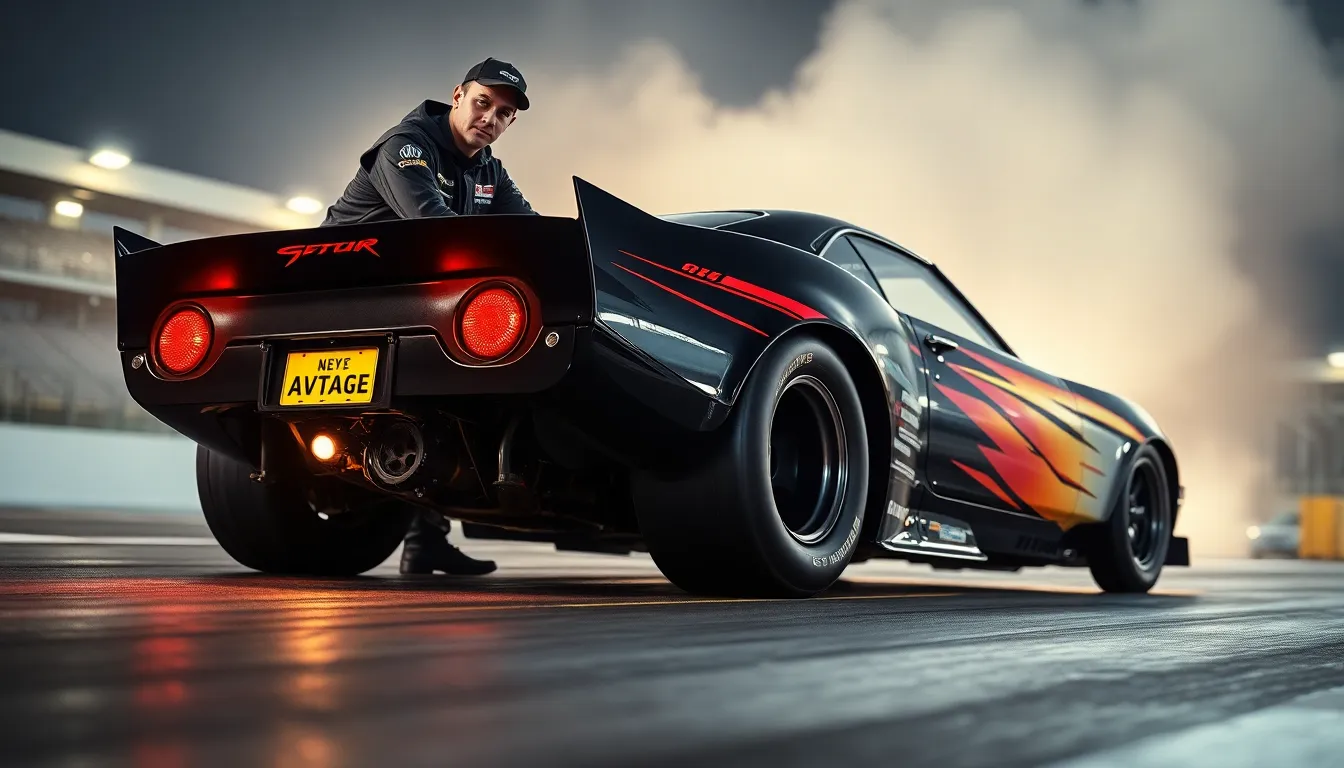
Building competitive drag cars requires strategic modifications that maximize power delivery while maintaining control at high speeds. We’ll explore the critical upgrades that transform ordinary vehicles into quarter-mile champions.
Engine Performance Enhancements
Forced induction systems deliver the most dramatic horsepower gains for drag car engines. Turbochargers and superchargers can increase power output by 50-100% over naturally aspirated configurations, with superchargers providing immediate power delivery that’s ideal for drag racing launches.
Nitrous oxide injection systems offer adjustable power increases ranging from 75 to 500 horsepower. Progressive nitrous controllers allow drivers to stage power delivery throughout the quarter-mile run, maximizing traction in early gears while unleashing full power at higher speeds.
Internal engine modifications form the foundation of serious drag car performance. Forged pistons, connecting rods, and crankshafts handle the extreme cylinder pressures generated by forced induction and nitrous systems, while high-flow cylinder heads improve breathing capacity.
Fuel system upgrades become critical as horsepower increases beyond stock levels. High-capacity fuel pumps, larger injectors, and racing fuel cells ensure adequate fuel delivery under extreme acceleration forces, preventing dangerous lean conditions that can destroy engines.
Exhaust system optimization reduces backpressure and enhances engine breathing through headers, high-flow catalytic converters, and straight-through mufflers. Professional drag cars often run open headers for maximum flow, though street-legal builds require more restrictive systems.
Suspension and Tire Considerations
Rear suspension modifications focus on maximizing traction during launches while maintaining straight-line stability. Drag racing exact shocks, adjustable rear springs, and traction bars help transfer weight to the rear wheels while preventing wheel hop that robs power.
Front suspension adjustments reduce weight transfer and maintain steering control at high speeds. Lowering springs, upgraded shock absorbers, and strut tower braces create a stable platform that keeps the front wheels planted during acceleration.
Drag racing tires provide the crucial connection between power and pavement through specialized compound formulations. Mickey Thompson, Hoosier, and M&H drag radials offer superior traction compared to street tires, with wrinkle-wall slicks delivering maximum grip for serious racing applications.
Wheel and tire sizing affects both performance and handling characteristics significantly. Narrow front runners (typically 2.5-4 inches wide) reduce rolling resistance and improve aerodynamics, while wide rear tires (10-18 inches) maximize contact patch for traction.
Tire pressure optimization requires careful adjustment based on track conditions and vehicle weight. Lower pressures (8-12 psi) create larger contact patches but can cause tire roll-over, while higher pressures (15-20 psi) maintain sidewall stability at the expense of traction.
Safety Equipment Required for Drag Car Racing
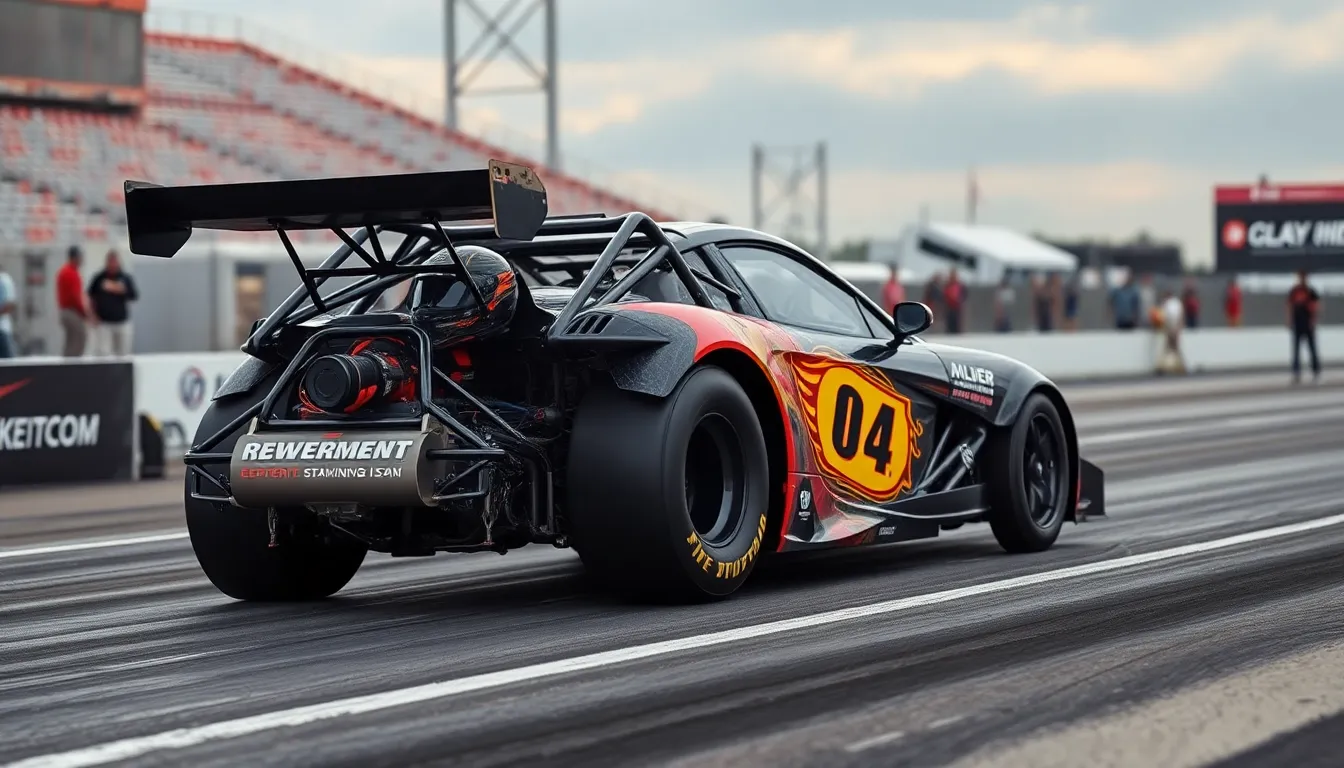
Drag racing’s extreme speeds and powerful acceleration forces demand comprehensive safety equipment that protects drivers and prevents catastrophic accidents. Professional sanctioning bodies like the NHRA establish strict safety standards that vary based on vehicle performance levels and racing categories.
Roll Cages and Fire Suppression Systems
Roll cages form the backbone of drag car safety, providing structural protection during potential rollovers or impacts at speeds exceeding 200 mph. Professional drag cars require multi-point roll cage construction using chromoly steel tubing with exact diameter requirements ranging from 1.75 to 2.00 inches depending on vehicle weight and performance class. SFI-certified roll cages must undergo rigorous testing and inspection to ensure they meet established safety standards for competition use.
Fire suppression systems become mandatory for vehicles running faster than exact elapsed time thresholds, typically requiring installation in cars achieving quarter-mile times under 10 seconds. Automatic fire suppression systems activate upon impact or manual trigger, releasing fire-retardant chemicals throughout the driver compartment and engine bay within seconds. NHRA-approved systems include brands like SPA Technique and Lifeline, which feature redundant activation methods and sufficient chemical capacity to suppress fuel fires effectively.
Fuel cell installation replaces factory gas tanks in competitive drag cars, featuring impact-resistant construction with foam baffles that prevent fuel slosh and reduce fire risk during accidents. These specialized cells include military-grade materials and safety valves that automatically shut off fuel flow during severe impacts or rollovers.
Driver Protection Gear and Regulations
Driver suits provide critical protection against fire hazards and impact injuries, with multi-layer construction rated for exact temperature exposure times. SFI-rated suits range from 3.2A/1 for entry-level competition to 3.2A/20 for Top Fuel and Funny Car racing, with higher ratings offering extended fire protection up to 40 seconds. Professional drivers often choose suits from manufacturers like Simpson Racing and Sparco that combine lightweight materials with maximum protection levels.
Helmet requirements vary significantly based on vehicle performance, with faster cars mandating full-face helmets featuring advanced impact absorption and fire-resistant materials. Snell SA-rated helmets meet exact motorsports standards and include features like forced-air ventilation systems and quick-release mechanisms for emergency situations. HANS (Head and Neck Support) devices become mandatory for professional competition, reducing the risk of basilar skull fractures during high-speed impacts.
Racing harness systems replace factory seatbelts with five or six-point configurations that distribute impact forces across the driver’s body more effectively. These systems must meet SFI specifications and undergo regular inspection and replacement schedules, typically requiring renewal every two years for competitive use. Proper installation angles and mounting points ensure maximum effectiveness during both frontal impacts and potential rollover scenarios.
Window nets prevent driver extremities from extending outside the vehicle during accidents while allowing easy escape access through quick-release mechanisms. Racing seats with integrated head and neck restraints provide additional support during high-acceleration launches and emergency situations, featuring aluminum or carbon fiber construction for optimal strength-to-weight ratios.
Famous Drag Racing Venues and Their Significance
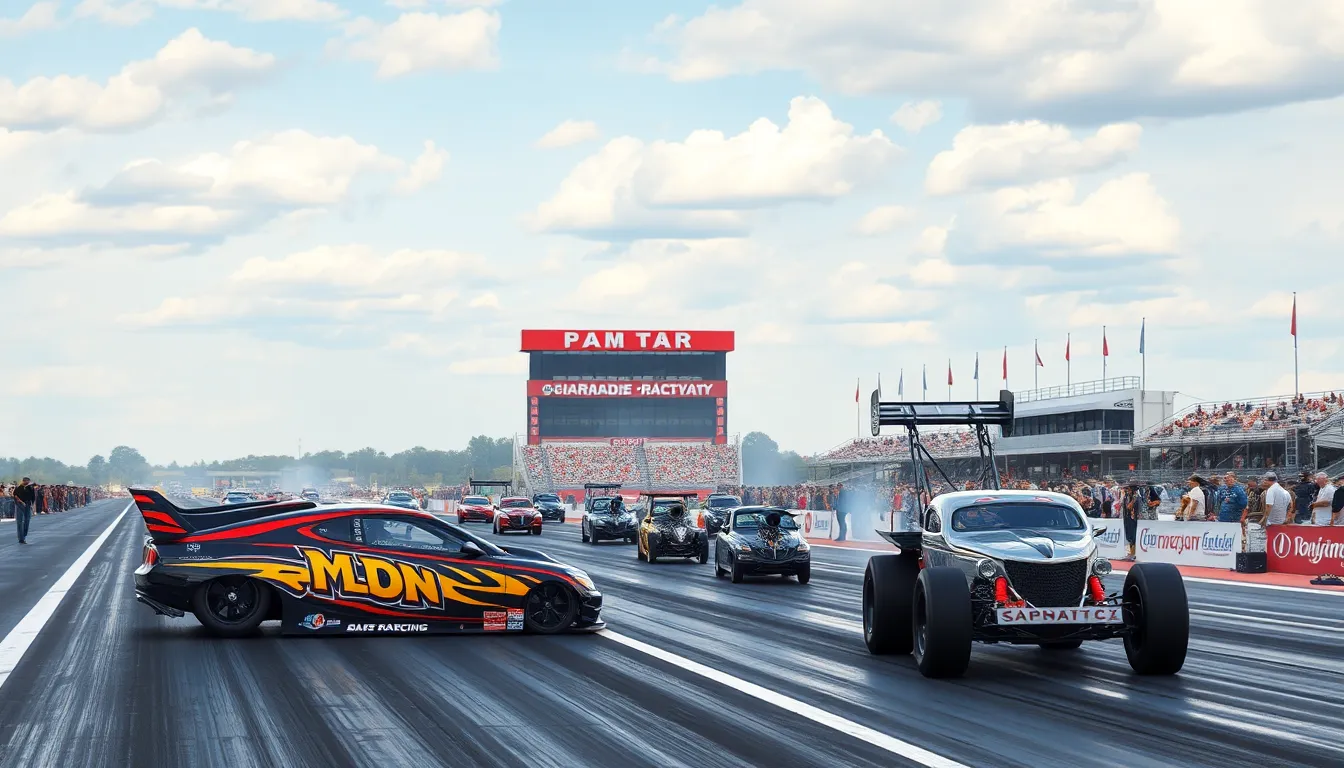
Professional drag racing venues serve as the cathedrals of quarter-mile competition, where records are broken and legends are born. These iconic facilities have shaped the sport’s evolution while hosting the industry’s most prestigious racing events.
Historic Tracks and Championship Events
Indianapolis Raceway Park stands as one of America’s most celebrated drag racing destinations, hosting the prestigious NHRA U.S. Nationals since 1961. We recognize this facility as the sport’s crown jewel, where drivers compete for the most coveted title in drag racing history. The track’s quarter-mile surface has witnessed countless record-breaking runs, including multiple Top Fuel elapsed time records under 3.70 seconds.
Auto Club Raceway at Pomona represents the birthplace of modern NHRA championship racing, serving as the season opener and finale for professional drag racing circuits. Racing legends like Don Garlits and Shirley Muldowney established their careers on this historic California strip. The facility’s concrete surface provides optimal traction conditions, enabling consistently fast elapsed times across all professional categories.
Bristol Dragway in Tennessee has earned its reputation as “Thunder Valley” through decades of thrilling competition and record-setting performances. Professional teams regularly achieve career-best elapsed times on this legendary track, which features exceptional track preparation and ideal weather conditions during major events. The venue’s mountainous backdrop creates a dramatic setting that enhances the spectacle of high-speed drag racing.
Gainesville Raceway holds special significance as the host of the NHRA Gatornationals, one of the sport’s most prestigious events since 1970. Championship contenders often use this Florida facility to establish early-season momentum, while the track’s consistent surface conditions make it a favorite among professional racing teams. Weather patterns in central Florida provide favorable racing conditions that contribute to exceptional performance numbers.
International Drag Racing Locations
Santa Pod Raceway in England serves as Europe’s premier drag racing destination, featuring the continent’s only FIA-sanctioned quarter-mile facility. European Top Fuel and Funny Car teams regularly compete at this venue, which hosts the European Drag Racing Championship series. The track’s unique atmosphere combines British motorsport tradition with American-style drag racing excitement.
Sydney Dragway anchors Australia’s professional drag racing scene, hosting the Australian Nationals and serving as the home base for the country’s Top Fuel championship series. Racing teams from across the Pacific region converge on this New South Wales facility, where summer racing conditions provide ideal performance opportunities. The venue’s modern safety equipment and track preparation standards rival those of premier American facilities.
Bandimere Speedway near Denver represents high-altitude drag racing at its finest, challenging teams to adapt their tuning strategies for thin air conditions at 5,800 feet above sea level. Professional crews must recalibrate their engines and aerodynamic setups to compensate for reduced atmospheric pressure. The track’s mountainous setting creates one of motorsport’s most visually stunning racing environments.
Wild Horse Pass Motorsports Park in Arizona has emerged as a modern drag racing showcase, featuring state-of-the-art timing systems and track surface technology. Championship teams appreciate the facility’s consistent weather conditions and exceptional track preparation, which contribute to reliable performance data throughout racing weekends. The venue regularly hosts both NHRA and IHRA professional events, establishing its credentials among premier American drag strips.
Conclusion
The industry of drag racing continues to evolve with incredible diversity and innovation. From the thunderous roar of Top Fuel dragsters to the silent acceleration of electric vehicles we’re witnessing a sport that embraces both tradition and cutting-edge technology.
Whether you’re drawn to the nostalgic appeal of classic muscle cars or the precision engineering of modern Pro Stock machines the drag strip offers something for every automotive enthusiast. We’ve seen how proper modifications safety equipment and venue selection all contribute to this thrilling motorsport.
As drag racing moves forward we expect to see even more exciting developments in electric vehicle technology while the timeless appeal of nitromethane-fueled machines keeps drawing crowds. The quarter-mile will always remain the ultimate test of automotive performance and engineering excellence.
Frequently Asked Questions
What is drag racing and how fast do the cars go?
Drag racing is a form of automotive competition where two cars race down a quarter-mile strip for speed. Cars can accelerate from zero to over 300 mph, with Top Fuel dragsters reaching speeds over 330 mph in just 1,000 feet. The sport showcases incredible engineering prowess across various vehicle categories.
How much horsepower do Top Fuel dragsters produce?
Top Fuel dragsters generate over 11,000 horsepower using supercharged 500-cubic-inch V8 engines fueled by nitromethane. This fuel produces nearly twice the horsepower of gasoline-powered vehicles, consuming about 15 gallons during a single quarter-mile run. They hold records for fastest acceleration of any land vehicle.
What are Funny Cars and how are they different from other drag cars?
Funny Cars feature one-piece fiberglass bodies that flip forward to reveal mechanical components. They’re designed to minimize drag and maximize downforce at speeds exceeding 330 mph. The engine is positioned behind the driver, and carbon fiber construction keeps body weight around 200 pounds for optimal performance.
What modifications are essential for building competitive drag cars?
Essential modifications include engine performance enhancements like turbochargers and nitrous oxide systems, fuel system upgrades, exhaust optimization, and suspension modifications for better traction. Specialized drag racing tires, weight reduction, and safety equipment are also critical for competitive performance and driver protection.
Are electric cars competitive in drag racing?
Yes, electric drag cars are revolutionizing the sport with instant torque and impressive quarter-mile performance. Models like the Tesla Model S Plaid, Lucid Air Dream, and Rimac Nevera achieve remarkable times while producing zero direct emissions. They offer lower maintenance and consistent performance across varying conditions.
What safety equipment is required for drag racing?
Professional drag cars require multi-point roll cages made from chromoly steel, fire suppression systems, and specialized fuel cells. Drivers must wear SFI-rated suits, helmets, and racing harness systems. Window nets, racing seats, and parachute deployment systems for high-speed vehicles are also mandatory safety features.
What are some famous drag racing venues?
Notable venues include Indianapolis Raceway Park, Auto Club Raceway at Pomona, Bristol Dragway, and Gainesville Raceway in the US. International locations include Santa Pod Raceway in England, Sydney Dragway in Australia, Bandimere Speedway in Colorado, and Wild Horse Pass Motorsports Park in Arizona.

